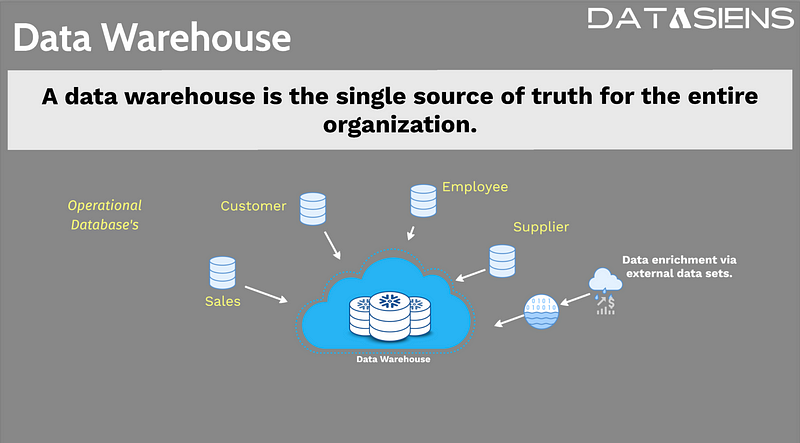Imagine a world where a data warehouse serves as the single source of truth for an entire organization, providing valuable insights derived from structured data sources. But this hasn't always been the case. Let's embark on a journey that takes us from the realm of proprietary hardware stacks to the game-changing era of cloud data warehousing.
Unveiling the Data Warehouse

The data warehouse serves as the cornerstone for organizing and analyzing structured data. By collecting information from operational databases and transforming it into a format conducive to analytics, organizations can tap into its immense potential. Operational databases, designed for transactions, may not be ideal for analytical purposes. Querying them directly can hamper application performance. Thus, the need for a data warehouse emerges, ensuring efficient querying and enabling businesses to thrive.
Interacting with the Data Warehouse

Data scientists are the torchbearers of insight, constantly seeking features to enhance their models. The data warehouse becomes their treasure trove, offering a vast array of structured data for exploration. However, access to the data is often restricted, with data catalogs providing a preview of available data sets. Data scientists must adapt their skills and strategies to navigate the data warehouse effectively, extracting valuable features for model training.
Transferring Data to the Data Mart
Once the data scientist identifies the necessary data for training models, they collaborate with the data engineering team. The data engineering team facilitates the transfer of data from the data warehouse to a data mart or even a feature store. Whether it's a one-time transfer or a scheduled process, fresh data is made available for model training, unlocking new possibilities for enhanced analytics.
From Model Training to Predictions
The data scientist utilizes a data science platform or their development environment to engineer features and preprocess data for model training. Crucially, these tasks are performed within the data mart or feature store rather than directly within the data warehouse. Once the model is trained, predictions or inferences are made against the data mart, storing the results for dashboards and applications that leverage the predictive capabilities.
Cloud Data Warehousing: The Game Changer

The evolution of data warehousing leads us to the era of cloud data warehousing. Traditional on-premise hardware stacks have given way to cloud-based infrastructure, revolutionizing the data warehousing landscape. Cloud data warehouses, such as Google BigQuery and Amazon Redshift, decouple compute and storage, providing flexibility in scaling and sizing based on specific needs. They are fully managed services, freeing organizations from the burden of infrastructure management. Additionally, cloud data warehouses often support querying semi-structured data, broadening their scope and utility.
Snowflake — the leader in cloud datawarehousing

Lets look at what makes Snowflake so special and why its becoming a defacto standard for cloud datawarehousing.
- Decoupling Compute and Storage for Flexibility
Cloud data warehouses, like Snowflake, offer a unique advantage: the decoupling of compute and storage. This separation enables organizations to dynamically adjust the size and capacity of their data warehouses based on specific needs, all on-demand. Whether running monthly reports or day-to-day operations, Snowflake allows for seamless scaling, optimizing resource allocation and cost efficiency. - Native Support for Semi-Structured
Data Traditionally, data warehousing was associated with structured data. However, Snowflake is pushing boundaries by providing native support for querying semi-structured data. With this breakthrough capability, Snowflake ensures that organizations can harness the power of structured, unstructured, and semi-structured data within a single technology stack. This eliminates the need for separate tools and simplifies the data ecosystem. - Multipurpose Functionality
Snowflake doesn't stop at being a data warehouse. Its flexibility extends to serving as a data mart and even a feature store. While specialized feature stores hold certain advantages, Snowflake integrates seamlessly with them, offering the best of both worlds. This multipurpose functionality eliminates the need for multiple technologies and streamlines data management, enhancing overall efficiency. - Managed Services for Unmatched Ease
One of the key advantages of Snowflake and cloud data warehousing, in general, is the fully managed service it provides. With Snowflake, organizations are relieved of the burdens associated with infrastructure management and software updates. The cloud provider handles all the backend processes, allowing data professionals to focus solely on data loading, extraction, and value extraction. - A Game-Changer for Modern Enterprises
Snowflake's innovations and comprehensive approach to data warehousing have positioned it as a game-changer for modern enterprises. The technology's ability to adapt to different use cases and its support for diverse data types make it a versatile solution. From acting as a feature store to serving as a data warehouse, Snowflake provides organizations with a unified platform that caters to their evolving needs.
Embracing the Power of Data Warehousing
As we conclude this exploration of data warehousing, it's important to recognize the significance of this technology in empowering organizations to derive valuable insights. While the journey from proprietary stacks to cloud data warehousing has brought about remarkable advancements, it's crucial to adapt and understand the limitations and challenges associated with accessing data in a data warehouse. Modern architectures like data lakes and data lakehouses are emerging to complement traditional warehousing approaches, while technologies like vector databases are enabling new AI-driven use cases.